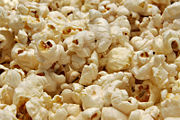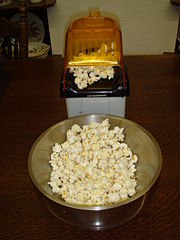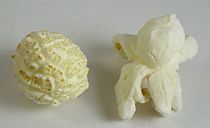Popcorn
| Popcorn | ||||||||||||||||||
|---|---|---|---|---|---|---|---|---|---|---|---|---|---|---|---|---|---|---|
 Popcorn on the cob, freshly harvested.
 Popped popcorn, ready for eating.
|
||||||||||||||||||
| Scientific classification | ||||||||||||||||||
|
||||||||||||||||||
| Binomial name | ||||||||||||||||||
| Zea mays averta |
Popcorn or popping corn is a type of corn which explodes from the kernel and puffs up when heated. Special varieties are grown to give improved popping yield. Some wild types will pop, but the cultivated strain is Zea mays averta, which is a special kind of flint corn. The process of making popcorn was first discovered by Native Americans thousands of years ago.[1]
Contents |
History
Popcorn was first discovered by the Native Americans, who believed that the popping noise was that of an angry god who escaped the kernel.[2]
During the Great Depression popcorn was comparatively cheap at 5-10 cents a bag and became popular. Thus, while other businesses failed the popcorn business thrived and became a source of income for some struggling farmers.[3] During World War II, sugar rations diminished candy production causing Americans to eat three times more popcorn than they had before.[3]
At least six localities (all in the United States) claim to be the "Popcorn Capital of the World": Valparaiso, Indiana; Van Buren, Indiana; Marion, Ohio; Ridgway, Illinois; Schaller, Iowa; and North Loup, Nebraska. According to the USDA, most of the maize used for popcorn production is specifically planted for this purpose; most is grown in Nebraska and Indiana, with increasing area in Texas.[4]
As the result of an elementary school project, popcorn became the official state snack food of Illinois.[5]
How popcorn pops

Each kernel of popcorn contains a certain amount of moisture and oil. Unlike most other grains, the outer hull of the popcorn kernel is both strong and impervious to moisture, and the starch inside consists almost entirely of a hard, dense type.[6]
As the oil and the water are heated past the boiling point, they turn the moisture in the kernel into a superheated pressurized steam, contained within the moisture-proof hull. Under these conditions, the starch inside the kernel gelatinizes, softening and becoming pliable. The pressure continues to increase until the breaking point of the hull is reached: a pressure of about 135 psi (930 kPa)[6] and a temperature of 180°C. The hull ruptures rapidly, causing a sudden drop in pressure inside the kernel and a corresponding rapid expansion of the steam, which expands the starch and proteins of the endosperm into airy foam. As the foam rapidly cools, the starch and protein polymers set into the familiar crispy puff.[6]
Methods of popping
Although small quantities can be popped in a stovetop kettle in a home kitchen, commercial sale of freshly popped popcorn is done with the help of specially designed popcorn machines, which were originally invented in Chicago, Illinois by Charles Cretors in 1885. Cretors successfully introduced his invention at the Columbian Exposition in 1893. (At this same world's fair, F.W. Rueckheim introduced the first caramel corn; his brother, Louis, slightly altered the recipe and introduced it as Cracker Jack popcorn in 1896.[7])
Cretors' invention introduced the first patented steam-driven popcorn machine that popped corn in oil. Previously, vendors popped corn by holding a wire basket over an open flame. At best, the result was a hot, dry, unevenly cooked confection. The Cretors' machine popped corn in a mixture of one-third clarified butter, two-thirds lard and salt. This mixture could withstand the 450°F temperature needed to pop corn and it did without producing much smoke. A fire under a boiler created steam that drove a small engine; that engine drove the gears, shaft, and agitator that stirred the corn and also powered the attention-attracting clown – the Toasty Roasty Man. A wire connected to the top of the cooking pan allowed the operator to disengage the drive mechanism, lift the cover, and dump popped corn into the storage bin beneath. Exhaust from the steam engine was piped to a hollow pan below the corn storage bin and kept freshly popped corn uniformly warm for the first time ever.[8]

An equally ingenious popcorn making device can still be seen on the streets of some Chinese cities today. The corn is poured into a large cast-iron canister which is then sealed with a heavy lid and slowly turned over a curbside fire in rotisserie fashion. When a pressure gauge on the canister reaches a certain level, it is removed from the fire, a large canvas sack is put over the lid, and the seal is released. With a huge boom, all of the popcorn explodes at once and is poured into the sack.
Individual consumers can also buy and use specialized popping appliances which typically generate no more than a gallon of popped corn per batch. Some of these appliances also accept a small volume of oil or melted butter to assist thermal transfer from a stationary heating element, but others (such as the one pictured here) are "air poppers" which rapidly circulate heated air up through the interior, keeping the unpopped kernels in motion to avoid burning and blowing the popped kernels out through the chute.[9]
However, the great majority of popcorn sold for home consumption is now packaged for use in a microwave oven. Some of the most popular brands of microwavable popcorn today are Orville Redenbacher's, Pop Secret, Act II, Jolly Time, and private label brands.[10]
Expansion and yield
Popping results are sensitive to the rate at which the kernels are heated. If heated too quickly, the steam in the outer layers of the kernel can reach high pressures and rupture the hull before the starch in the center of the kernel can fully gelatinize, leading to partially popped kernels with hard centers. Heating too slowly leads to entirely unpopped kernels: the tip of the kernel, where it attached to the cob, is not entirely moisture-proof, and when heated slowly, the steam can leak out of the tip fast enough to keep the pressure from rising sufficiently to break the hull and cause the pop.[11]
Producers and sellers of popcorn consider two major factors in evaluating the quality of popcorn: what percentage of the kernels will pop, and how much each popped kernel expands. Expansion is an important factor to both the consumer and vendor. For the consumer, larger pieces of popcorn tend to be more tender and are associated with higher quality. For the grower, distributor, and vendor, expansion is closely correlated with profit: vendors such as theaters buy popcorn by weight and sell it by volume. For both these reasons, higher-expansion popcorn fetches a higher profit per unit weight.
Popcorn will pop when freshly harvested, but not well: its high moisture content leads to poor expansion and chewy pieces of popcorn. Kernels with a high moisture content are also susceptible to mold when stored. For these reasons, popcorn growers and distributors dry the kernels until they reach the moisture level at which they expand the most. This differs by variety and conditions, but is generally in the range of 14–15% moisture by weight. If the kernels are over-dried, the expansion rate will suffer and the percentage of kernels that pop at all will decline.
Two explanations exist for kernels which do not pop at proper temperatures, known in the popcorn industry as "old maids". The first is that unpopped kernels do not have enough moisture to create enough steam for an explosion. The second explanation, according to research led by Dr. Bruce Hamaker of Purdue University, is that the unpopped kernel may have a leaky hull.
Popcorn varieties are broadly categorized by the shape of the kernels, the color of the kernels, or the shape of the popped corn. While the kernels may come in a variety of colors, the popped corn is always white as it is only the hull (or pericarp) that is colored. "Rice" type popcorns have a long kernel pointed at both ends; "pearl" type kernels are rounded at the top. Commercial popcorn production has moved mostly to pearl types.[12] Historically, pearl popcorns were usually yellow and rice popcorns usually white. Today both shapes are available in both colors, as well as others including black, red, and variegated. Commercial production is dominated by white and yellow.[13]

In popcorn jargon, a popped kernel of corn is known as a "flake". Two shapes of flakes are commercially important. "Butterfly" flakes are irregular in shape and have a number of protruding "wings". "Mushroom" flakes are largely ball-shaped, with few wings. Butterfly flakes are regarded as having better mouthfeel, with greater tenderness and less noticeable hulls. Mushroom flakes are less fragile than butterfly flakes and are therefore often used for packaged popcorn or confectionery, such as caramel corn.[13] The kernels from a single cob of popcorn may form both butterfly and mushroom flakes; hybrids that produce 100% butterfly flakes or 100% mushroom flakes exist, the latter developed only as recently as 1998.[13] Growing conditions and popping environment can also affect the butterfly-to-mushroom ratio.
As a food
Popcorn is usually served salted or sweetened. In North America, it is traditionally served salted, although a sweetened version, generally called caramel corn, is also commonly available. In the United Kingdom, ready-made popcorn is available either salted or simply sweetened with sugar, both varieties being equally popular. Toffee (i.e. caramel) popcorn is also available, but tends to be more expensive. Popcorn is a popular snack at sporting events and in cinemas, where it has been served since 1912. The Boy Scouts of America sell popcorn door-to-door as a primary fundraiser, similar to Girl Scout cookies.[14]
Nutritional value
| Popcorn, air-popped, no additives Nutritional value per 100 g (3.5 oz) |
||||||||||||||
|---|---|---|---|---|---|---|---|---|---|---|---|---|---|---|
| Energy 380 kcal 1600 kJ | ||||||||||||||
|
||||||||||||||
| One cup is 8 grams. Percentages are relative to US recommendations for adults. Source: USDA Nutrient database |
||||||||||||||
Air-popped popcorn is naturally high in fiber, low in calories and fat, contains no sodium, and is sugar free. This can make it an attractive snack to people with dietary restrictions on the intake of calories, fat, and/or sodium. For the sake of flavor, however, large amounts of fat, sugar, and sodium are often added to prepared popcorn, which can quickly convert it to a very poor choice for those on restricted diets.
One particularly notorious example of this first came to public attention in the mid-1990s, when the Center for Science in the Public Interest produced a report about "Movie Popcorn", which became the subject of a widespread publicity campaign. The movie theaters surveyed used coconut oil to pop the corn, and then topped it with butter or margarine. "A medium-size buttered popcorn", the report said, "contains more fat than a breakfast of bacon and eggs, a Big Mac and fries, and a steak dinner combined."[15] The practice continues today. For example, according to DietFacts.com, a small popcorn from Regal Cinema Group (the largest theater chain in the United States[16]) still contains 29g of saturated fat,[17] as much as three Big Macs[18] and the equivalent of a full day-and-a-half's reference daily intake.[19]
Health risks
Popcorn is included on the list of foods that the American Academy of Pediatrics recommends not serving to children under four, because of the risk of choking.[20] Special "hulless" popcorn has been developed that offers an alternative for small children and for people with braces or other dental problems who may otherwise need to avoid popcorn.
Microwaveable popcorn represents a special case, since it is designed to be cooked along with its various flavoring agents. One of these common artificial-butter flavorants, diacetyl, has been implicated in causing respiratory ailments.[21]
Other uses
Popcorn, threaded onto a string, is used as a wall or Christmas tree decoration in some parts of North America, as well as on the Balkan peninsula.
Some shipping companies have experimented with using popcorn as a biodegradable replacement for expanded polystyrene packing material. However, popcorn has numerous undesirable properties as a packing material, including attractiveness to pests, flammability, and a higher cost and greater density than expanded polystyrene. A more processed form of expanded corn foam has been developed to overcome some of these limitations.[22]
The world's largest popcorn ball was unveiled in October 2006 in Lake Forest, Illinois. It weighed 3,415 pounds (1550 kilograms), measured 8 feet (2.4 m) in diameter, and had a circumference of 24.6 feet (8 m).[23]
See also
- Kettle corn
- Caramel corn
- Popcorn bag
- Popcorn brands
- Popcorn maker
- Butter salt
- Puffed grain
References
- ↑ "Popcorn History".
- ↑ "Who discovered Popcorn?".
- ↑ 3.0 3.1 "Encyclopedia Popcornica: Recent Popcorn History".
- ↑ "United States Department of Agriculture - 1982 Popcorn Report". Reports for other years also available.
- ↑ Illinois Government News Network (2003-08-04). "Governor Signs Official Snack Bill: School Project Becomes Law". Press release. Retrieved on 2007-08-25.
- ↑ 6.0 6.1 6.2 Lusas & Rooney, p. 388.
- ↑ Brief History of Cracker Jack. http://www.crackerjack.com/history.php
- ↑ "C. Cretors and Company". Wyandot Popcorn Museum. Retrieved on 2008-11-21.
- ↑ Michael Pollick. "What is an Air Popper?". WiseGeek.com. Retrieved on 2008-11-21.
- ↑ "An American Original: The Popularity of Microwave Popcorn Just Keeps Growing", AllBusiness, May 1, 2006
- ↑ Lusas & Rooney, pp. 388–389.
- ↑ Hallauer, p. 213.
- ↑ 13.0 13.1 13.2 Hallauer, p. 214.
- ↑ Trail's End - America's Favorite Popcorn
- ↑ New York Times, "How About Some Popcorn With Your Fat", by William Grimes; May 1, 1994
- ↑ Regal Entertainment: About Us
- ↑ DietFacts.com Regal Cinemas Nutrition Information
- ↑ McDonald's Corporation Nutritional Information
- ↑ FDA Daily Reference Values
- ↑ "Prevent Your Child From Choking". FDA Consumer Magazine Sep–Oct 2005 issue. URL retrieved Jan 6 2007.
- ↑ Geis, Sonya. "Flavoring Suspected in Illness: Calif. Considers Banning Chemical Used in Microwave Popcorn." The Washington Post, 7 May 2007
- ↑ "Real Popcorn as Packing Material", Abbey Newsletter (April 1992).
- ↑ The Popcorn Factory
Other sources
- Hallauer, Arnel R. (2001). Specialty Corns. CRC Press. ISBN 0849323770.
- Lusas, Edmund W.; Rooney, Lloyd W. (2001). Snack Foods Processing. CRC press. ISBN 1566769329.
- Smith, Andrew F. (1999). Popped Culture: The Social History of Popcorn in America. University of South Carolina Press. ISBN 1570033005.